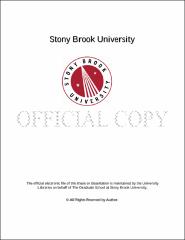| dc.identifier.uri | http://hdl.handle.net/11401/77243 | |
| dc.description.sponsorship | This work is sponsored by the Stony Brook University Graduate School in compliance with the requirements for completion of degree. | en_US |
| dc.format | Monograph | |
| dc.format.medium | Electronic Resource | en_US |
| dc.language.iso | en_US | |
| dc.publisher | The Graduate School, Stony Brook University: Stony Brook, NY. | |
| dc.type | Dissertation | |
| dcterms.abstract | Snakes are a speciose, ecologically diverse clade with an evolutionary history spanning the past 100 million years. This diversity makes them an excellent group for study, particularly given their importance in extant faunas. However, the fossil record of snakes is primarily composed of isolated vertebrae, owing to the great number of these elements and loosely articulated nature of the skull. This means that any study of the paleobiology of extinct snakes must rest primarily on vertebrae. The purpose of this dissertation is to add to the current knowledge of snake vertebral ecomorphology, and to begin to extend that understanding to the fossil record. This is accomplished by two approaches. The first is a pair of studies of the variation within the column of single individuals (intracolumnar variation). The first study is of basal snakes, including the scolecophidian Afrotyphlops lineolatus, and three alethinophidians: the boid Boa constrictor, the xenopeltid Xenopeltis unicolor, and the pythonid Python molurus. The second study is of caenophidians (" advanced" snakes), and includes the acrochordid Acrochordus javanicus, the colubrine Pituophis melanoleucus, the natricine Nerodia taxispilota, and the pseudoxyrhophiine Leioheterodon madagascariensis. In each snake, a series of 20 measurements was made on each vertebra in the column; two measurements were replaced in the cloacal and caudal regions because of differing morphology resulting in a total of 22 measurements. When plotted against vertebral position, the measurements revealed the pattern of change in morphology throughout the trunk in these snakes. The results show that almost all snakes have a distinct anterior trunk region characterized by tall neural spines and hypapophyses. The results also indicate that some snakes have decreased regionalization of the column. The phylogenetic distribution of this homogenization indicates that multiple lineages have evolved this pattern of intracolumnar variation. The second part of this dissertation is a study of the relationship between ecology and the number of vertebrae. Vertebral number is correlated with locomotory performance in other animals as well as some snakes. I therefore modeled the evolution of body segment number to see if it is under selection based on several ecological parameters, or if it is essentially a random walk (Brownian motion). The first step was to test for the presence of directional evolution throughout the clade toward higher counts, using BayesTraits to create the models. Directional evolution was not preferred to the null hypothesis of undirected evolution. The second step was to test for selection toward certain optimal body segment numbers based on ecological parameters. Three models of explicit selection using Ornstein-Uhlenbeck processes were explicitly tested, in addition to the null hypothesis of Brownian motion: one model of a single global optimum for all of snakes, a second of two optima, with snakes separated by mode of prey subjugation (constriction vs. nonconstriction), and a third of four optima, with snakes separated by habitat preference (aquatic, arboreal, fossorial, terrestrial). The results strongly support the presence of selection over a random walk; furthermore, there is support for the four-optima model using habitat preference. | |
| dcterms.available | 2017-09-20T16:52:16Z | |
| dcterms.contributor | Kley, Nathan J | en_US |
| dcterms.contributor | Krause, David | en_US |
| dcterms.contributor | Demes, Brigitte | en_US |
| dcterms.contributor | Turner, Alan | en_US |
| dcterms.contributor | Moon, Brad. | en_US |
| dcterms.creator | McCartney, Jacob | |
| dcterms.dateAccepted | 2017-09-20T16:52:16Z | |
| dcterms.dateSubmitted | 2017-09-20T16:52:16Z | |
| dcterms.description | Department of Anatomical Sciences. | en_US |
| dcterms.extent | 148 pg. | en_US |
| dcterms.format | Application/PDF | en_US |
| dcterms.format | Monograph | |
| dcterms.identifier | http://hdl.handle.net/11401/77243 | |
| dcterms.issued | 2015-08-01 | |
| dcterms.language | en_US | |
| dcterms.provenance | Made available in DSpace on 2017-09-20T16:52:16Z (GMT). No. of bitstreams: 1
McCartney_grad.sunysb_0771E_11529.pdf: 53096583 bytes, checksum: 49bb4a8adc353e2ec4998ff707de6989 (MD5)
Previous issue date: 2013 | en |
| dcterms.publisher | The Graduate School, Stony Brook University: Stony Brook, NY. | |
| dcterms.subject | axial skeleton, comparative methods, ecomorphology, intracolumnar variation, Serpentes, vertebral number | |
| dcterms.subject | Biology | |
| dcterms.title | Morphology and Function of the Ophidian Vertebral Column: Implications for the Paleobiology of Fossil Snakes | |
| dcterms.type | Dissertation | |

